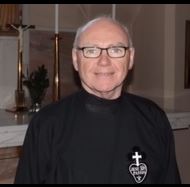In last Wednesday’s Gospel Jesus described himself as the Vine, and I was prompted to recall a memorable visit I once made to a vineyard in France.
From 1990 until 2007, the Passionists in France had a community in a little town called Verdelais, which is situated in the Entre-Deux-Mers wine region of Bordeaux, between the rivers Garonne and Dordogne, It’s a very beautiful region, and I had the good fortune to visit there a couple of times for meetings, early in this millennium, when I was secretary to the North European Conference of Passionists.
Verdelais is home to a Shrine of Our Lady, Consoler of the Afflicted, which can be dated back to the early 12th Century, when a knight named Gerald de Graves, who had become a hermit and settled in the local forest, built a chapel to house a statue of the Virgin Mary which he claimed to have brought back from the First Crusade to the Holy Land. Apparently, the building of this chapel was as a result of a promise made to Our Lady if she would bring him safely home, which she did. At his death, a community of monks came to keep the devotion going and to welcome pilgrims. Many miracles attributed to the shrine attracted a growing number of pilgrims down the years, and the shrine has now survived for nine centuries, albeit with a couple of restorations, during which it has witnessed wars, revolutions, and other assaults. In more recent times, before the Passionists went there, it was looked after by Marist monks, and when the Passionists left there in 2007, to open up an International House of Hospitality in Lourdes, it was taken over by Marianists who, so far as I know, are still there. In the little graveyard in Verdelais, the artist Henri Toulouse-Lautrec is buried.
While in Verdelais, when I wasn’t taking notes at meetings, I liked to wander through the Entre-Deux-Mers vineyards, and in the very structure of the vines: the trunk, the canes, the shoots, the leaves, and of course the grapes, the image of the vine presented by Jesus would come alive for me in a way that I wouldn’t normally have experienced in Scotland or Ireland, where I have mostly lived, and where the climate doesn’t really lend itself to vineyards.
On one occasion, as a cultural experience, the French Passionists in Verdelais brought us to visit a local vineyard where we were given the guided tour. At the end of the tour we were seated around a beautiful courtyard and given two glasses of wine and a few nibbles. We were told that one was quite a cheap wine, while the other was a very expensive wine. Afterwards, our host went around us one by one, I think there were about twenty of us, Passionists from Scotland, Ireland, England, Belgium, Holland, Poland, Germany and France, and he asked us which of the two wines we had preferred. To a man, and much to the disgust of our host, we all chose the cheap wine. I can’t speak for the others, but really, how could a poor boy from Partick be a connoisseur of anything, other than perhaps Barrs Irn Bru?
The image of the vine is one of the seven “I Am” statements of Jesus. If you recall the story of the burning bush in the Book of Exodus, you will remember God saying to Moses “I Am who I Am”, and in the Gospel Jesus asks His disciples, “Who do you say I Am?” So, these “I Am” statements of Jesus are considered to be expressions of who He truly is, the Beloved Son of God, and declarations of His divinity. They are all worth repeating here:
I am the bread of life; I am the light of the world. I am the gate; I am the good shepherd, I am the resurrection and the life; I am the way, the truth and the life and, last but not least, perhaps the best kept till the end, I am the vine.

 RSS Feed
RSS Feed
